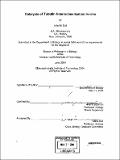| dc.contributor.advisor | Frank Solomon. | en_US |
| dc.contributor.author | Doll, John M., 1976- | en_US |
| dc.contributor.other | Massachusetts Institute of Technology. Dept. of Biology. | en_US |
| dc.date.accessioned | 2006-03-29T18:28:31Z | |
| dc.date.available | 2006-03-29T18:28:31Z | |
| dc.date.copyright | 2004 | en_US |
| dc.date.issued | 2004 | en_US |
| dc.identifier.uri | http://hdl.handle.net/1721.1/32259 | |
| dc.description | Thesis (Ph. D.)--Massachusetts Institute of Technology, Dept. of Biology, 2004. | en_US |
| dc.description | Includes bibliographical references. | en_US |
| dc.description.abstract | The heterodimerization of α- and β-tubulin represents a critical early step in microtubule morphogenesis. In vitro studies have defined a pathway that mediates the incorporation of monomeric tubulin polypeptides into heterodimer. The components of this pathway, tubulin cofactors, are dispensable for growth in Saccharomyces cerevisiae under laboratory conditions. Yet, these proteins are required for survival under conditions of stress or in the presence of a weakened tubulin heterodimer. This finding suggests cofactors may function in vivo to promote reformation of dissociated tubulin heterodimer. In order to carry out this activity, cofactors are thought to facilitate the association of tubulin monomers without likewise promoting the dissociation of tubulin heterodimer. However, the mechanism of cofactor activity in vivo and the method by which these proteins achieve vectorial catalysis of heterodimerization has remained obscure. In this study, we present evidence that several endogenous tubulin cofactors associate with one another in vivo and bind tubulin monomer under conditions of stress. We also provide physical and genetic data suggesting that Cin4p, an ARF family GTPase, associates with the tubulin cofactor Cin1 p (cofactor D) and promotes tubulin heterodimerization by modulating Cin1 p's association with β-tubulin. Through site-directed mutagenesis, we conclude that Cin4p GTPase activity is important for these functions. These data support a model in which the production of tubulin heterodimer via a putative cofactor complex is coupled to nucleotide hydrolysis by a small GTPase. The linkage of these reactions could serve to impart directionality to the activity of tubulin cofactors, allowing them to selectively promote tubulin heterodimerization without also catalyzing heterodimer dissociation. | en_US |
| dc.description.statementofresponsibility | by John M. Doll. | en_US |
| dc.format.extent | 150 leaves | en_US |
| dc.format.extent | 5159976 bytes | |
| dc.format.extent | 5157414 bytes | |
| dc.format.mimetype | application/pdf | |
| dc.format.mimetype | application/pdf | |
| dc.language.iso | eng | en_US |
| dc.publisher | Massachusetts Institute of Technology | en_US |
| dc.rights | M.I.T. theses are protected by copyright. They may be viewed from this source for any purpose, but reproduction or distribution in any format is prohibited without written permission. See provided URL for inquiries about permission. | en_US |
| dc.rights.uri | http://dspace.mit.edu/handle/1721.1/7582 | |
| dc.subject | Biology. | en_US |
| dc.title | Catalysis of tubulin heterodimerization in vivo | en_US |
| dc.title.alternative | Catalysis of tubulin heterodimer reassembly | en_US |
| dc.type | Thesis | en_US |
| dc.description.degree | Ph.D. | en_US |
| dc.contributor.department | Massachusetts Institute of Technology. Department of Biology | |
| dc.identifier.oclc | 56024348 | en_US |
